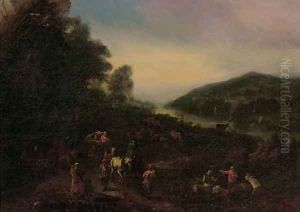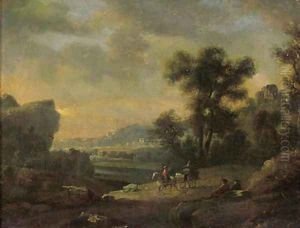Pieter Bout And Adriaen Fransz. Boudewijns Paintings
Pieter Bout and Adriaen Fransz. Boudewijns were two distinct artists from the Flemish school who collaborated frequently, contributing to the flourishing art scene in the Southern Netherlands during the 17th century. Pieter Bout was born in Brussels around 1658 or 1660 and is known for his lively and detailed landscapes and cityscapes. Adriaen Fransz. Boudewijns, on the other hand, was born in Hulst around 1644 and died in 1711 in Brussels. Boudewijns is celebrated for his exquisite landscape and marine paintings, often enriched with architectural elements.
The collaboration between Bout and Boudewijns was a common practice among artists of the period, combining their skills to create more complex and appealing works. Bout was primarily responsible for the figures and animals within the landscapes, while Boudewijns concentrated on the landscapes and backgrounds. This partnership allowed them to produce works of art that were rich in detail and vibrant in composition, making their paintings highly sought after by collectors of the time.
Throughout their careers, both artists were influenced by the dominant Baroque style, integrating its dynamic compositions and dramatic use of light and shadow into their works. However, they also incorporated elements of the emerging Flemish tradition, which emphasized detailed naturalism and a more serene approach to landscape painting. Their works often depicted rural scenes, bustling marketplaces, and serene harbors, capturing the essence of life in the Southern Netherlands during the 17th century.
Despite their productive collaboration, Bout and Boudewijns also enjoyed successful solo careers. Pieter Bout’s travels to France and the Dutch Republic allowed him to absorb a wide range of artistic influences, which he integrated into his paintings. Adriaen Fransz. Boudewijns, meanwhile, remained primarily in Brussels, where he became a master in the Guild of Saint Luke in 1675, contributing significantly to the city’s artistic legacy.
The legacy of Bout and Boudewijns today rests on their ability to blend their talents so seamlessly, creating works that are appreciated for their technical skill, vibrant storytelling, and the harmonious integration of human figures within lush landscapes. Their paintings can be found in various museums and private collections worldwide, serving as enduring examples of the fruitful collaboration that defined much of Flemish art during their time.

